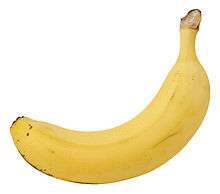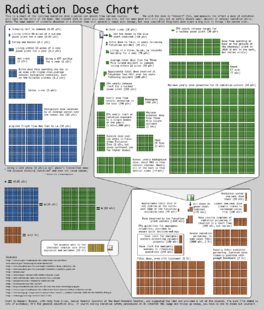Banana equivalent dose

Banana Equivalent Dose (BED) is an informal expression of ionizing radiation exposure, intended as a general educational example to indicate the potential dose due to naturally occurring radioactive isotopes by eating one average-sized banana. One BED is often taken as 0.1 µSv, however, in practice this dose is not cumulative, as the principal radioactive component is excreted to maintain metabolic equilibrium. The BED is only an indicative concept meant to show the existence of very low levels of natural radioactivity within a natural food and is not a formally adopted dose quantity.
For example, the radiation exposure from consuming a banana is approximately 1% of the average daily exposure to radiation, which is 100 banana equivalent doses (BED). The maximum permitted radiation leakage for a nuclear power plant is equivalent to 2,500 BED (250 μSv) per year, while a chest CT scan delivers 70,000 BED (7 mSv). A lethal dose of radiation is approximately 35,000,000 BED (3500 mSv). A person living 16 kilometres (10 mi) from the Three Mile Island nuclear reactor received an average of 800 BED of exposure to radiation during the 1979 accident.[1]
History
The concept probably originated on the RadSafe nuclear safety mailing list in 1995, where a value of 9.82×10−8 sieverts or about 0.1 μSv was suggested for a 150-gram banana.[2]
Although this unit is not formally adopted, the use of the word "equivalent" may still cause confusion. Properly, any dose quantity, which is a measure of the health effect of radiation on the whole body, is known as an "effective" dose. Equivalent doses only relate to specific organs of the body.
Source of radioactivity

The major natural source of radioactivity in plant tissue is potassium: 0.0117% of the naturally occurring potassium is the unstable isotope potassium-40 (40K). This isotope decays with a half-life of about 1.25 billion years (4×1016 seconds), and therefore the radioactivity of natural potassium is about 31 Bq/g – meaning that, in one gram of the element, about 31 atoms will decay every second.[3][4] Plants naturally contain radioactive carbon-14 (14C), but in a banana containing 15 grams of carbon this would give off only about 3 to 5 beta rays per second. Since a typical banana contains about half a gram of potassium,[5] it will have an activity of roughly 15 Bq.[6] Although the amount in a single banana is small in environmental and medical terms, the radioactivity from a truckload of bananas is capable of causing a false alarm when passed through a Radiation Portal Monitor used to detect possible smuggling of nuclear material at U.S. ports.[7]
The dose uptake from ingested material is defined as committed dose, and in the case of the overall effect on the human body of the radioactive content of a banana, it will be the "committed effective dose". This is typically given as the net dose over a period of 50 years resulting from the intake of radioactive material.
According to the US Environmental Protection Agency (EPA), isotopically pure potassium-40 will give a committed dose equivalent of 5.02 nanosieverts over 50 years per becquerel ingested by an average adult.[8] Using this factor, one banana equivalent dose comes out as about 5.02 nSv/Bq × 31 Bq/g × 0.5 g ≈ 78 nSv = 0.078 μSv. In informal publications, one often sees this estimate rounded up to 0.1 μSv.[9]
However, the committed dose in the human body due to bananas is not cumulative because the amount of potassium (and therefore of 40K) in the human body is fairly constant due to homeostasis,[10][11] so that any excess absorbed from food is quickly compensated by the elimination of an equal amount.[2][12]
It follows that the additional radiation exposure due to eating a banana lasts only for a few hours after ingestion, i.e. the time it takes for the normal potassium content of the body to be restored by the kidneys. The EPA conversion factor, on the other hand, is based on the mean time needed for the isotopic mix of potassium isotopes in the body to return to the natural ratio after being disturbed by the ingestion of pure 40K, which was assumed by EPA to be 30 days.[10] If the assumed time of residence in the body is reduced by a factor of ten, for example, the estimated equivalent absorbed dose due to the banana will be reduced in the same proportion.
These amounts may be compared to the exposure due to the normal potassium content of the human body, 2.5 g per kg,[13] or 175 grams in a 70 kg adult. This potassium will naturally generate 175 g × 31 Bq/g ≈ 5400 Bq of radioactive decays, constantly through the person's adult lifetime.
Radiation from other foods
Other food rich in potassium (and therefore in 40K) include potatoes, kidney beans, sunflower seeds, and nuts.[14][15] Brazil nuts in particular are not only rich in 40K but may also contain significant amounts of radium, which have been measured at up to 444 Bq/kg (12 nCi/kg).[16][17] Some types of table salt can contain trace amounts of radium;[18] while tobacco contains traces of thorium, polonium and uranium.[19][20]
See also
- Background radiation
- Committed dose
- List of humorous units of measurement
- Naturally occurring radioactive material (NORM)
References
- ↑ "Three Mile Island Accident". Retrieved 2015-10-25.
...The average radiation dose to people living within 10 miles of the plant was 0.08 millisieverts...
- 1 2 RadSafe mailing list: original posting and follow up thread. FGR11 discussed.
- ↑ The activity of one gram of natural potassium is the number of atoms of 40K in it, divided by the average lifetime of a 40K atom in seconds. The number of atoms of 40K in one gram of natural potassium is 40K's mole-fraction (0.000117) times Avogadro's number 6.022×1023 (the number of atoms per mole) divided by the relative atomic mass of potassium (39.0983 grams per mole), namely about 1.80×1018 per gram. As in any exponential decay, the average lifetime is the half-life (3.94 × 1016 seconds) divided by the natural logarithm of 2, or about 5.684×1016 seconds.
- ↑ Bin Samat, Supian; Green, Stuart; Beddoe, Alun H. (1997). "The 40K activity of one gram of potassium". Physics in Medicine and Biology. 42 (2): 407. Bibcode:1997PMB....42..407S. doi:10.1088/0031-9155/42/2/012.
- ↑ "Bananas & Potassium". Retrieved 2011-07-28.
...the average banana contains about 422 mg of potassium...
- ↑ Tom Watson (Feb 26, 2012). "Radioactive Banana! Peeling Away the Mystery". (Accessed 14 March 2012).
- ↑ Issue Brief: Radiological and Nuclear Detection Devices. Nti.org. Retrieved on 2010-10-19.
- ↑ Federal Guidance Report #11 (table 2.2, page 156) Lists conversion factor of 5.02×10−9 Sv/Bq for committed effective dose equivalent of ingested pure potassium-40 (not of natural potassium).
- ↑ Radiation chart
- 1 2 U. S. Environmental Protection Agency (1999), Federal Guidance Report 13, page 16: "For example, the ingestion coefficient risk for 40K would not be appropriate for an application to ingestion of 40K in conjunction with an elevated intake of natural potassiumm. This is because the biokinetic model for potassium used in this document represents the relatively slow removal of potassium (biological half-time 30 days) that is estimated to occur for typical intakes of potassium, whereas an elevated intake of potassium would result in excretion of a nearly equal mass of natural potassium, and hence of 40K, over a short period."
- ↑ Eisenbud, Merril; Gesell, Thomas F. (1997). Environmental radioactivity: from natural, industrial, and military sources. Academic Press. pp. 171–172. ISBN 978-0-12-235154-9.
It is important to recognize that the potassium content of the body is under strict homeostatic control and is not influenced by variations in environmental levels. For this reason, the dose from 40K in the body is constant.
- ↑ Maggie Koerth-Baker (Aug 27, 2010). "Bananas are radioactive—But they aren't a good way to explain radiation exposure". (Accessed 25 May 2011). Attributes the title statement to Geoff Meggitt, former UK Atomic Energy Authority.
- ↑ Thomas J. Glover, comp., Pocket Ref, 3rd ed. (Littleton: Sequoia, 2003), p. 324 (LCCN 2002-91021), which in turn cites Geigy Scientific Tables, Ciba-Geigy Limited, Basel, Switzerland, 1984.
- ↑ Environmental and Background Radiation, Health Physics Society.
- ↑ Internal Exposure from Radioactivity in Food and Beverages, U.S. Department of Energy (archived from the original on 2007-05-27).
- ↑ http://www.orau.org/PTP/collection/consumer%20products/brazilnuts.htm Brazil Nuts]. Orau.org. Retrieved on 2010-10-19.
- ↑ Natural Radioactivity. Physics.isu.edu. Retrieved on 2010-10-19.
- ↑ https://www.sciencebasedmedicine.org/pass-the-salt-but-not-that-pink-himalayan-stuff/
- ↑ http://www.owndoc.com/pdf/radiation-of-tobacco.pdf
- ↑ http://www.sciencedirect.com/science/article/pii/S0531513104018072